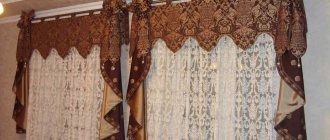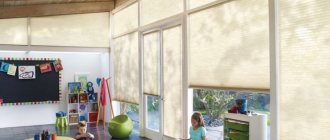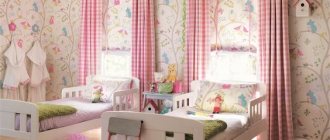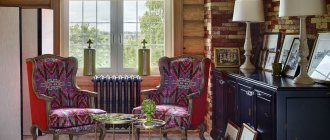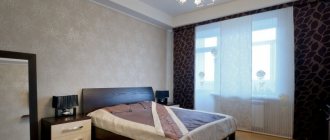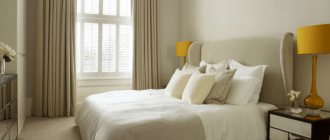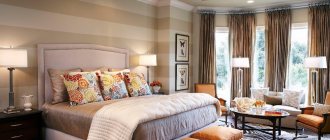Classics in the interior remain in demand and relevant today and will not go out of fashion for a long time. Therefore, we determine which curtains can be called classics, and how to correctly choose curtains in a classic style for the living room. Let's consider the positive aspects and disadvantages of the decision to purchase such curtains. We’ll tell you how diverse the choice of classic curtains is and give some methods for attaching them.
Classic style curtains Source plpstatic.ru
Style features
Curtains in a classic interior must:
- have a traditional and carefully thought-out design;
- be decorated in harmonious colors;
- be made from exquisite and rich fabrics of natural origin;
- be decorated with elegant accessories;
- be proportionally cut.
Beauty, dignity, elegance - that's all about them. In a traditional interior, it is recommended to decorate the window with drapes, curtains and a lambrequin. The curtains are gathered at the sides and secured with tiebacks.
The combination of light and heavy materials, a scrupulously verified color scheme, repeated in the color scheme of other interior details, help make the interior sound and thoughtful.
It is also worth remembering that the classic style is not acceptable:
- excessive brevity and simplicity;
- daring experiments;
- ignoring traditions.
If you are a connoisseur of tradition, then classic curtains will be the best option for you.
Browse by room
Bedroom and children's room
For bedrooms in a classic style, delicate shades of light green, blue, and cream are suitable. Here it is recommended to combine curtains with tulle or Roman blinds.
In the photo, the color and pattern of the curtains matches the wallpaper on the accent wall in the bedroom.
Living room
In the living room you can experiment with the color of curtains and their shape. A soft lambrequin will decorate a spacious room in the Baroque style. French curtains can serve as transparent tulle along with thick curtains.
The photo shows the interior of a living room in a house with second light, where light curtains do not draw attention to themselves.
Curtains for the kitchen in a classic style
For the kitchen, you can use light curtains in a classic style, which will let in sunlight and harmonize with the color of the set.
The luxurious dining room will be decorated with beige or olive curtains along with translucent tulle.
Bathroom
Roman, roller or French curtains in a classic style in light blue or white with a pattern are suitable for the bathroom.
When choosing the type and color of curtains in a classic style, it is important to take into account the size of the room, the level of natural light, decorative elements, and proper care of the fabric guarantees a long service life.
Advantages
Classic curtains have the following advantages:
- a wide range of;
- versatility;
- relevance over a long period of time;
- luxurious and elegant appearance;
- the ability to make the room feel comfortable;
- the ability to disguise interior imperfections.
Material of manufacture
Classic curtains are made from noble fabrics. The most common options are:
- Made of silk. Pros: good strength properties, light resistance, good drapability, aesthetics.
- Made from taffeta. It has a dense texture. Forms beautiful wide folds. Pros: durability with proper care, excellent water-repellent properties.
- From the atlas. Pros: characteristic shine, ability to dry quickly, impossibility of electrification. The downside is that it is demanding when it comes to washing.
- Made from brocade. Pros: attractive appearance, dense texture, poor creasing, rigidity. The downside is the weight.
- Made of velvet. Pros: durability, good drapability, ability to retain heat, breathability.
- Made from jacquard. Pros: large pattern, dense texture, wear resistance, resistance to fading, rigidity. Minus - you can’t wring it out during the washing process.
- Made from chenille. Pros: resistance to wear, tactile pleasantness, resistance to sunlight, wide choice of colors and patterns.
Varieties
Photos of classic curtains clearly illustrate the fact that they can be presented:
Roman curtains. This product has the appearance of a canvas, which, due to a special opening system, forms beautiful horizontal folds. There are two methods of fastening - to the window or to the window opening. Pros: aesthetic appearance, ease of maintenance. This is an ideal option for a small room.
Long curtains. Curtains of this type can either reach the floor or fall onto it. They are usually collected on the sides and secured with decorative ties. Sometimes curtains are complemented with a light curtain gathered in waves.
French curtains. Graceful waves of translucent fabric on panoramic windows create a festive atmosphere in any room. The stationary option can be supplemented with curtains by replacing them with tulle curtains. The product with a lifting device can be assembled into a lambrequin.
Interesting solutions in the interior
With non-standard use of classic curtains in the interior, it is possible to radically transform the window opening, its size, visually enlarge it, or, conversely, limit the area of the entire room.
To change the size of the window, the curtains must be placed on the sides so that they are a few centimeters further from the window opening itself. Thus, the window will visually increase. To visually lengthen the opening, you need to use a curtain clip, gathering them slightly above the middle.
If you want to lengthen a room, you need to use narrow curtains. Wide curtains are suitable if you want to visually make the room more spacious.
Fabric selection
The impression of classic curtains directly depends on the quality and appearance of the material used to sew them. The following types of fabric are traditionally used:
- silk and satin;
- jacquard and chinil;
- brocade and velvet.
Despite the fact that these materials were used when decorating windows by our ancestors, they are still in demand by connoisseurs of interiors in the classic style.
The fabrics listed above are used to make curtains. For curtains, it is worth purchasing tulle, veil or organza.
What should you pay attention to?
When choosing classic curtains, you need to pay attention to various nuances. First of all, pay attention to the design of the room itself. Different prints can be used either on the walls or on the curtains, otherwise it will feel overwhelming.
The color scheme should also be combined with the walls or carpeting. Ensure that the room is pleasing to the eye. What different design methods look like using classic curtains can be seen in the photo.
Selection of cornice
Classic curtains in the living room, as well as in any other room, require the use of curtain rods. The most popular are baguettes. They can be made of wood, metal or plastic, imitating the texture of other materials. The baguette model allows you to hide guides for attaching curtains, tulle, and lambrequin.
Round cornices are also suitable for classics. Moreover, both tubular and profile. Connoisseurs of intricate shapes can take a closer look at forged models. These products are often decorated with additional decoration, patina and carvings.
Design of drawings
Classic does not accept bright patterns. This style is characterized by exquisite patterns with a symmetrical arrangement. The main types of patterns for classic curtains:
- wide stripes;
- small floral ornament;
- “monograms”, other “palace” variations;
- diamond grille;
- satin jacquard with roses and peonies;
- graceful plant weaves;
- large geometric patterns.
Noble colored fabrics go well with smooth satin, plain curtains, taffeta or tulle without embroidery.
Important! A large pattern visually increases the format of the premises, but hides the space of a small bedroom. For visual expansion, plain jacquard curtains, translucent tulle with sparse embroidery, and curtains with decorative colored inserts are suitable.
Mounting options for classic curtains
There are several ways to attach classic curtains to the cornice. The choice of a specific option depends on the weight of the fabric and the style of the room.
Curtains can be attached to eyelets - special rings sewn into the material. But this is more appropriate for neoclassicism. Or you can use ties. You just need to choose an original way of tying and a suitable color to make the curtains spectacular.
Fabric loops, similar to eyelets, are strung on the cornice. Their number and width depend on the weight of the fabric.
The drawstring camouflages the upper part of the cornice due to the high frill. This type of fastening is suitable in the following cases:
- the window is in a niche;
- tubular cornice;
- cafe curtains
Traditional type curtains are an excellent solution, although they require careful consideration of many points before purchasing them. The design of classic curtains should suit the design of the room and please its owner.
Lambrequin
It is often an addition, but can act as an independent element. The main role of the lambrequin is to decorate the upper part of the window, giving it a neat and graceful outline.
Can often go down and up. It is made in different variations: hard and soft, dense and slightly transparent.
Photos of classic curtains
Decor and accessories
Fastening can be carried out not only using classical methods. Arched windows are beautifully decorated with wooden brackets, on which fabric with even folds is casually thrown.
Complex styles with draperies are often complemented with textile accessories:
- brushes;
- fringe;
- cords;
- satin ribbons.
A characteristic decor is the tiebacks that secure sliding classic curtains.
A wide strip of main fabric is attached to both sides of the symmetrical composition. The material is beautifully draped by fixing it on brackets and complemented with bows or tassels.
